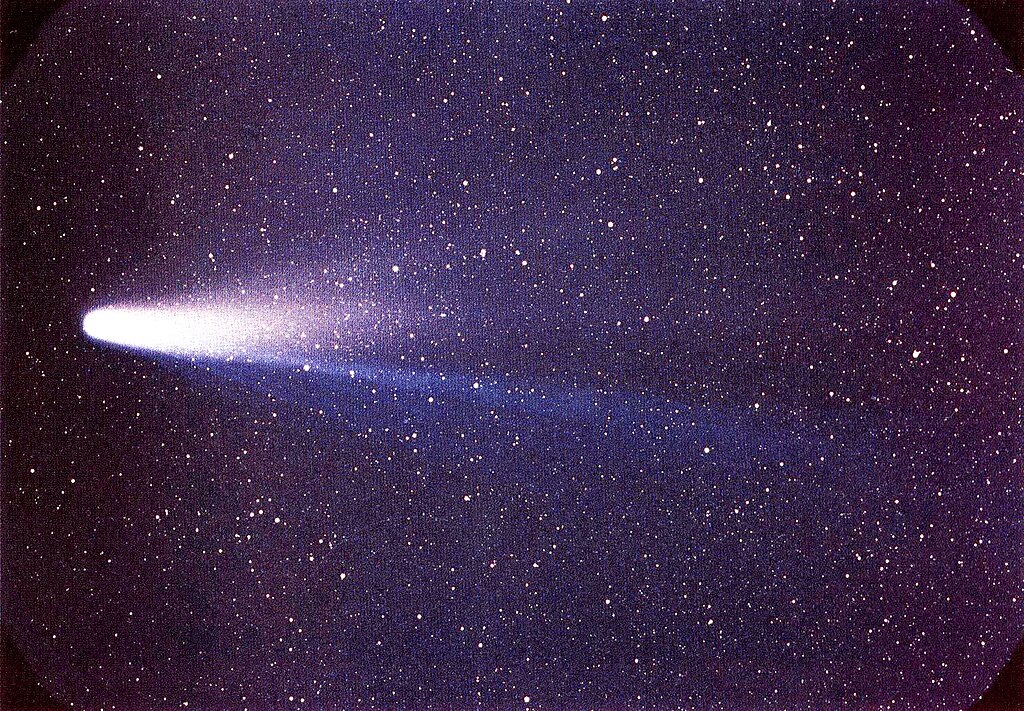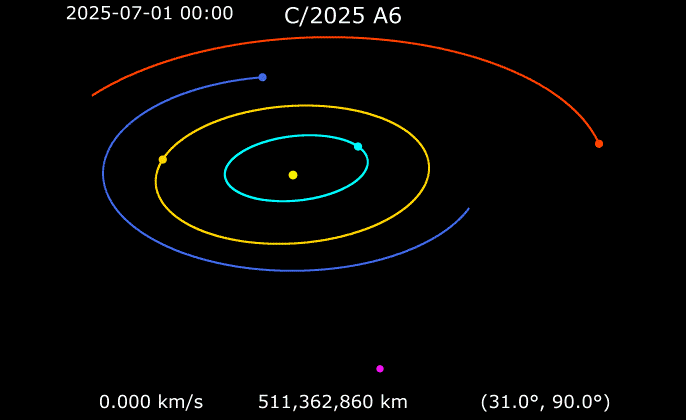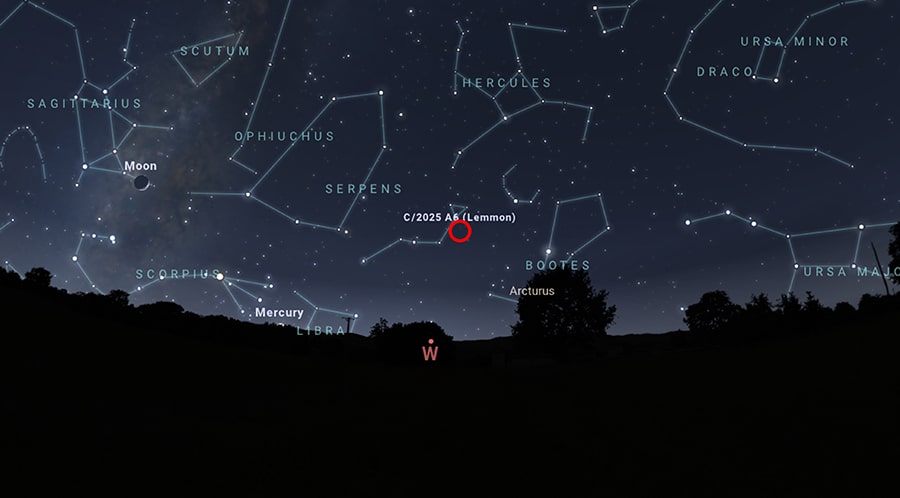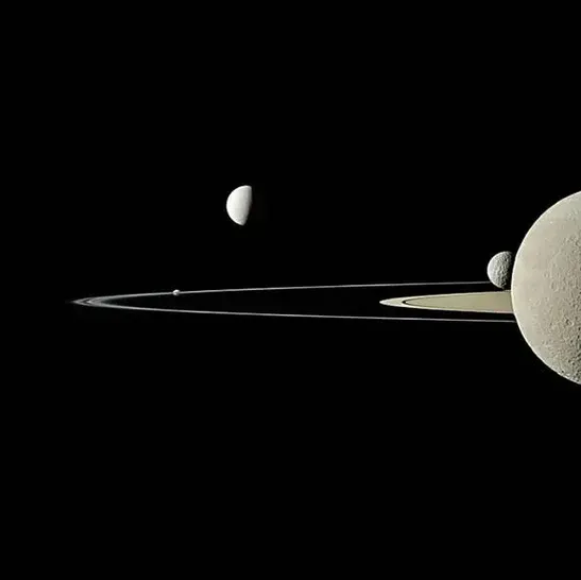Once-in-1,200-Years Opportunity
Discovered only earlier this year, a newly found comet is now making a close pass by both Earth and the Sun — presenting skywatchers with a once-in-a-millennium chance to catch a glimpse of it, though spotting it will be no easy feat.

30 October 2025
|

7 minutes
|
In January 2025, astronomers at the Mount Lemmon Observatory in Arizona discovered a new celestial object — a comet designated C/2025 A6. It was later named Lemmon, after the observatory that first identified it. As often happens, subsequent analysis revealed that the comet had actually appeared in earlier astronomical images but had gone unnoticed at the time.
These earlier observations, termed “precovery” (short for pre-discovery recovery) in astronomy, enabled scientists to calculate the comet’s orbital path and determine that it is an exceptionally rare visitor to our solar neighborhood. Comet Lemmon completes a single orbit around the Sun approximately every 1,350 years, spending only a brief moment of that vast journey close enough to be seen from Earth.
On October 21, the comet made its closest approach to our planet, and in the days that follow — late October through early November — it is expected to reach its peak brightness. Under optimal dark-sky conditions, observers may even be able to spot it with the naked eye, without the aid of telescopes or binoculars.

A distant preview — Comet Lemmon, captured on October 2 with a 70 mm telescope | Photo: Dimitrios Katevainis, Wikipedia
A Cosmic Body with a Tail
A comet is a small celestial object that orbits the Sun, much like an asteroid. The key difference between the two lies in their composition: comets are made primarily of ice, which traps gases, dust, and fragments of rock. Most comets follow highly elongated orbits, with the Sun located near one end of their path. This means they spend the majority of their time far from the Sun, in the cold reaches of space.
When a comet approaches the Sun, some of its icy surface begins to sublimate — turning directly from solid to gas — and releases the trapped dust and gases. This process forms a glowing tail that can stretch millions of kilometers into space. The luminous tail is what makes comets among the most striking sights in the night sky, sometimes visible even without a telescope.
Some comets develop more than one tail. This occurs when heavier particles such as dust are ejected along the comet’s orbital path, while lighter ions — electrically charged atoms — are swept away in a different direction by the solar wind, a continuous stream of charged particles emitted by the Sun. The colors of the tails depend on the composition of the materials released.
Comets with orbital periods shorter than about 200 years are called short-period comets or periodic comets. One of the most famous is Halley’s Comet, which returns to the inner solar system roughly every 76 years. It was named after the British astronomer Edmond Halley, who first recognized its periodic nature in 1705. In contrast, comets such as Lemmon, which take more than a thousand years to complete an orbit, are known as long-period comets.
Seasonal meteor showers occur when Earth passes through streams of debris left behind by certain comets during their orbits around the Sun. As tiny dust and rock particles enter Earth’s atmosphere at high speed, they burn up due to frictional heating, producing the bright streaks of light commonly known as “shooting stars.” At this moment, Earth is experiencing the peak of the Orionid meteor shower, whose meteors seem to radiate from the constellation Orion. In reality, these meteors are fragments shed from Halley’s Comet, encountered when Earth crosses the comet’s orbital path during our planet’s yearly revolution around the Sun.

A regular visitor to our cosmic neighborhood — and the source of several meteor showers. Halley’s Comet during its most recent pass near Earth in 1986 | Photo: NASA / W. Liller
The Fast Track
Since its discovery earlier this year, hundreds of observations have been made of Comet Lemmon, and it has been identified retrospectively in numerous earlier observations dating back to September 2024, when it was nearly 700 million kilometers from the Sun. However, because comet observations primarily capture the coma — the glowing envelope of gas and dust emitted from the nucleus — it is extremely difficult to estimate the comet’s actual size with precision.
Calculating a comet’s long-term orbit is an especially challenging task. Even Halley’s Comet, with its relatively short orbital period, is significantly affected by the gravitational forces of other bodies in the solar system, such as the planets. Its orbital period can deviate by as much as four years from the average. The longer a comet’s orbital cycle, the more difficult it becomes to determine its precise trajectory. Furthermore, as a comet approaches the Sun, the outgassing of volatile materials can both increase its velocity and reduce its mass, introducing additional changes to its speed and path.
According to current calculations, Comet Lemmon follows a highly elongated (eccentric) orbit. On November 8, it will reach its closest point to the Sun, approaching to within about 80 million kilometers — roughly 0.53 astronomical units (AU), where one AU equals the average distance between Earth and the Sun. At the farthest point in its orbit, the comet is expected to travel out to about 243 AU, or approximately 37 billion kilometers from the Sun. For comparison, the dwarf planet Pluto, residing on the outer edge of our solar system, orbits at an average distance of about 6 billion kilometers from the Sun.
Researchers predict that Comet Lemmon’s close approach to the Sun will slightly alter its orbit, increasing its speed and shortening its orbital period to about 1,150 years. This means the comet is expected to return around the year 3175 — far beyond the reach of any living observer today. That is, for those of us who are unlikely to exceed the limits of human lifespan, this current passage offers a once-in-a-lifetime opportunity to witness this extraordinary comet.

Watch the comet as it approaches the Sun. Orbital diagram of Comet C/2025 A6 (Lemmon) from July 2025 to January 2026 | Illustration: Phoenix7777, Wikipedia
A Matter of Brightness
Astronomers classify celestial objects using a scale known as apparent magnitude, which measures how bright an object appears — either from the light it emits or reflects — as seen from outside Earth’s atmosphere. The lower the apparent magnitude, the brighter the object appears. The scale is logarithmic, meaning that an object with a magnitude of 1 is not twice as bright as one with a magnitude of 2, but about 2.5 times brighter. Over time, negative values were added to represent exceptionally bright objects, such as the full Moon, which has an apparent magnitude of around –12.6.
When Comet Lemmon was first discovered, its apparent magnitude was extremely faint — about 21. As it approached Earth and the Sun, it gradually grew brighter. By September, its magnitude had dropped below 8, and by mid-October, some observations placed it below 5. According to the most optimistic forecasts, its brightness could reach magnitude 4.5 as it nears the Sun, while more conservative estimates suggest it may peak around magnitude 6.
People with normal vision can typically see objects as faint as magnitude 6 without optical assistance. However, visibility depends on several factors — including atmospheric clarity, transparency, and the level of light pollution at the observing site. Light pollution can come from artificial sources, but also from natural ones, especially the Moon. Therefore, even though an object of magnitude 4.5 should, in theory, be visible to the naked eye, in practice it requires ideal conditions — a dark, moonless sky far from city lights.
It’s worth noting that a comet’s predicted brightness is only an approximation. Estimating apparent magnitude in advance is inherently difficult — and for comets, particularly so. Consequently, while the chances of spotting Comet Lemmon are fairly good, you’ll likely need to venture beyond urban areas, away from city lights, and use optical aids such as binoculars. Even if it isn’t visible to the naked eye, there’s an excellent chance it will appear through binoculars. To help locate it, using a stargazing or sky-mapping app is highly recommended.

Look west shortly after sunset. The expected position of Comet Lemmon (circled) in the western sky on Sunday, October 26, at 18:00 UTC | Generated using the Stellarium app.
When and Where to See It
If you’re in the Northern Hemisphere, you have a chance to catch a glimpse of Comet Lemmon in the coming days. The best time to look is shortly after sunset, when the comet should be visible low in the west-northwest sky, just above the bright star Arcturus in the constellation Boötes (“the Herdsman”). As the days pass, the comet will gradually shift farther west. The end of daylight saving time in late October will bring earlier sunsets, giving observers in the U.S., U.K., and Europe slightly better evening viewing conditions — although the waxing Moon toward the end of the month may make the faint comet harder to spot.
The comet’s tail may extend about 2–3 degrees across the sky — roughly the width of four to six full moons — and appear as a thin, faint streak of light. Since its apparent brightness is expected to be near the limit of naked-eye visibility, your best chance of spotting it is from a dark, rural location, using binoculars or a small telescope on a clear night.
At the same time, you can also look out for meteors from the Orionid meteor shower, which peak in mid to late October. These meteors will appear in the opposite direction, rising from the east, and are easiest to see around midnight or in the early morning hours.
If you miss Comet Lemmon, don’t worry — You may not get another chance to see this particular comet, but astronomers have discovered nearly 5,000 comets in our solar system, and every few years another one passes close enough to provide skywatchers with another opportunity to witness a close celestial encounter.






